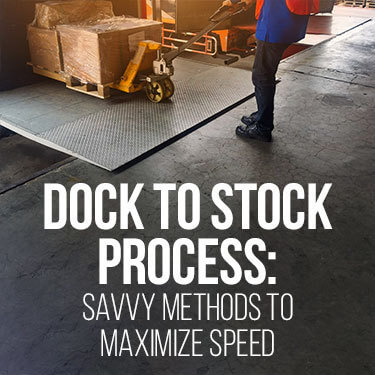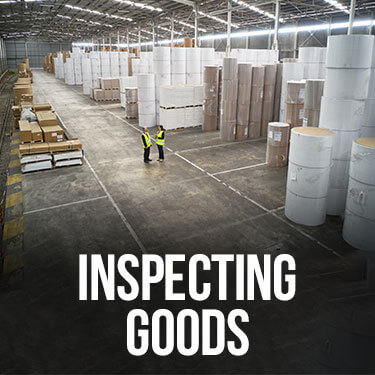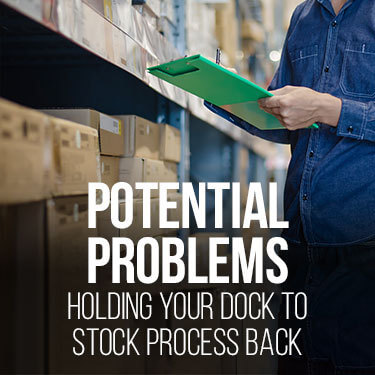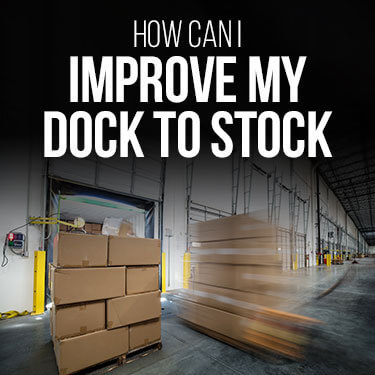
 Copy URL to Clipboard
Copy URL to Clipboard
When a trailer’s door rolls open, the dock to stock process doesn’t end until goods are placed in their designated area within the warehouse. Though this process is only four steps, each step is crucial and must be done carefully for the best result to be achieved. Many businesses struggle to perform this simple, but crucial logistical operation successfully. Fortunately, we have some tips that can help you improve your operations.
At R+L Global Logistics, our leadership team with a combined 80 years of logistics experience recommends using these tips to improve your dock to stock process:
Not only will we show you how to improve your dock to stock process, but we’ll also show you the inner workings of the process and how to identify potential problems within it.
Table of Contents

The dock to stock process begins when goods arrive at the loading docks of a warehouse. The process continues until the goods that arrived are sorted and placed in their designated areas. This can include on pallets, shelves or racks.
The dock to stock process is split into four unique parts which are:
These procedures must be completed effectively to have productive dock to stock cycle times, which is the amount of time that it takes to complete the process.
The first part of the dock to stock process is the receipt/receiving process. Trucks carrying products will arrive at the loading docks of a warehouse. Once they arrive, dock workers will begin unloading the trailer.
Handling equipment in these trailers can be difficult depending on how large and heavy it is. In some circumstances, a forklift will be needed to move heavier pallets out of the trailer. The goods that are unloaded will be placed in a safe area on the floor called the staging area. If the delivery driver has any concerns regarding the shipment, a supervisor should be nearby to help them.

Now that the goods are unloaded, receiving inspection can commence. The inspection process and receiving process is completed practically at the same time. As dock workers are unloading goods from the trailer, they’re also inspecting the product itself.
Inspecting the product includes performing tasks like:
This part of the dock to stock (DTS) process can take a long time. Because of this, many companies start to get bogged down during this step of the process.
When products have been unloaded off of a trailer and have been inspected, the next responsibility is to update the warehouse's stock levels. Updating stock levels is essential to inventory accuracy in a warehouse. The last thing you want is to think that you have more or less of a certain product than you do and end up with a stockout.
Mistakes can occur during this part of the dock to stock process for a few reasons. One reason is that sometimes, partial orders arrive rather than full ones. This can cause a warehouse worker to enter the same amount of inventory a second time when the completed order arrives.
After the stock levels of your warehouse have been updated, you can move on to storing the inventory. Storing the goods includes putting all relevant information into your warehouse's inventory management system. The size of the products can determine where the goods should be placed.

Assessing your dock to stock process while it’s in action is the best way to determine what problems might be plaguing it. Some of these problems can occur during or even before the dock to stock process begins.
Carrier problems are one of those issues that can affect the dock to stock process before it even starts. If your incoming product is constantly arriving late or is coming in damaged, chances are you might need to revisit your carrier options.
While mistakes can happen every so often, problems like these that constantly persist are unacceptable. Fortunately, there are numerous carriers that you can hire to transport your goods.
Warehouse operational capabilities are at their pique when management is performing well. Management can constitute anything from the direction of employees in the warehouse to organizing appointments for freight to come in.
If you have a yard that’s congested because of poor appointment scheduling or the staging area is filled with product that needs hasn’t be stored yet, poor management might be to blame.

Sometimes your docks and staging space area can look like a mess, not because of poor management, but because the volume of freight coming into your warehouse is too high to keep up with. Higher volumes of freight coming will necessitate more docks for trailers to be parked at.
More freight means that you will need larger staging areas and more storage space to put the freight that’s been unloaded. If you don’t have the space needed for the orders that are coming to your warehouse, your dock to stock cycle time will only begin to suffer.

You don’t have to panic if you’ve determined that you have some problems with your dock to stock process. There are numerous avenues that you can take to fix your DTS process and get back on track.
The purpose of a vendor compliance policy, or VCP, is to give your vendor a set of guidelines to follow when they send their products to you. When your vendor follows these guidelines correctly, your DTS process should be faster and smoother. Therefore, the guidelines you dictate to them should be drafted in a way that will make your job easier.
Another good method that can improve your dock to stock process is through shipping notifications. Getting notifications about products that are being shipped to your warehouse can be useful.
When you get a shipping notification, you’ll be able to prepare your warehouse team for the incoming shipment. This includes inspecting the staging area and any equipment that might need to be used to unload a trailer.
Earlier, we discussed that one potential problem that could be plaguing your dock to stock process is the lack of dock and staging area space. A good way to solve this problem is by outsourcing fulfillment to a 3PL.
Many businesses opt to use a 3PL when their fulfillment operations can no longer keep up with their order volume. Having another warehouse with more docks and staging areas will make up for the room that you don’t have at your facility.
Some other important benefits that outsourcing fulfillment operations to a 3PL can offer you include:
At R+L Global Logistics, we can offer all of these services to help your business. If you’re still not convinced about the services of 3PLs, look into our article on 3PL warehouse operations and the benefits of using one.

Worker fatigue is a very real problem, especially in a warehouse environment. Constant lifting, lowering and walking will eventually take a toll on your workers over time. Fatigue can also limit a worker's ability to inspect the products that they’ve unloaded and brought to the staging area. When your workers don’t get enough rest, their productivity will start to suffer.
There are numerous ways that you can prevent worker fatigue in the warehouse. First of all, pay attention to your workers and how they carry themselves. Many of them might not want to say anything, but if you pay attention just enough, you’ll be able to notice whether or not your workers are exhausted.
Another good way to prevent fatigue is to shorten shifts. This will allow workers to work shorter amounts of time before they go on break. Shortening shifts will also mean that you’ll need more shifts to account for the gaps in time.
Adding more shifts might cause some issues with organizing the employee schedule. If you don’t want to deal with the hassle of creating a new schedule, then consider adding more breaks to each shift. Instead of a worker getting one 30-minute break during a 10-hour shift, give them two instead.
When it comes to inspecting the product that’s just been unloaded off a trailer, there’s a lot of potential for miscounts to happen. That’s why it’s a good idea to have your warehouse staff adopt effective counting methods to reduce mistakes.
Instead of counting individual products, have your warehouse staff count inventory by boxes or pallets. Automating the process is a much better solution than manual counting as well. You can do this by equipping your staff in the unloading area with scanners.
Using these scanners, your staff can scan the barcode of you each box or pallet. Once scanned, your inventory management systems will automatically be updated with data about the items that are now in your warehouses’ possession.
To give an idea of scanners to choose from, we’ve listed some of the most popular scanners used in fulfillment warehouse operations along with their respective prices.
| Scanner Model | Price Of Scanner |
| Brainydeal USB Automatic Barcode Scanner | $32.99 |
| NADAMMOO Bur 3003 433Mhz Wireless Barcode Scanner | $59.99 |
| Honeywell 1900G-SR 2D Barcode Scanner | $180.00 |
| Symcode USB Barcode Scanner | 17.99 |
| Zebra/Motorola Symbol DS9808 Next-Generation Hybrid Presentation Imager/Barcode Scanner | $40.00 |
One great, but unexpected way to improve your dock to stock process, is to eliminate one part of the process altogether. Cross-docking is the service that will allow you to do that.
With cross-docking, products only spend a short period in storage. Oftentimes, goods that are unloaded will sit in the staging area briefly before being loaded into another trailer. Some other benefits of cross-docking include things like:
Outsourcing your fulfillment operations to a 3PL will improve your dock to stock process exponentially. Along with cross-docking, we’ll provide some other essential services that your business might also find useful, such as:
We help many different clients and we know that we’ll be able to do the same for you. Fill out your free quote today to get the fulfillment services you deserve.
